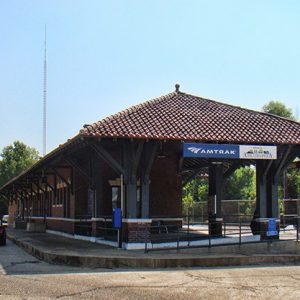calsfoundation@cals.org
Missouri Pacific Depot (Arkadelphia)
The Missouri Pacific Depot located in Arkadelphia (Clark County) is an active train station that was constructed in the Mediterranean style in 1910. Added to the National Register of Historic Places on June 11, 1992, it is located on South Fifth Street.
The first settlers arrived in the Arkadelphia area, located along the Ouachita River, around 1808, and it was incorporated in 1857. In 1873, river transportation was replaced by rail when the Cairo and Fulton connected the city with Little Rock (Pulaski County). The depot in Arkadelphia was constructed in 1910 by the St. Louis, Iron Mountain and Southern Railway to replace a previous depot that was destroyed in September 1909 by a fire at the adjacent Arkadelphia Roller Mill. The Iron Mountain was acquired by the Missouri Pacific in 1917, and the company constructed a number of new depots to serve communities along the tracks, including in Gurdon (Clark County).
The Arkadelphia depot was constructed south of downtown and sits to the northwest of the rail line. Constructed of red brick and with a red clay tile roof, the single-story structure is rectangular with a telegraph operator’s office jutting out toward the tracks. The southwest end of the building is an open platform. The northeast end originally included an open platform but was enclosed to house freight and other large items. The enclosed portion of the structure is clearly visible, as the bricks are a slightly different shade of red. It has an off-center wooden double door at the end that opens onto a small platform that is accessible from the street. This end of the building includes four six-paned windows on each side.
The side of the train depot facing the tracks features a door that was added when the freight area was enclosed, as well as two large freight doors. Three single doors are also on this side of the building, as well as fourteen one-over-one sash windows, one of which is covered with a sheet of wood.
The opposite side of the building features four doors. Two doors, roughly the size of double doors, are located near the enclosed northeast end of the building; their large size allowed the movement of large pieces of freight. The other two doors were designed to allow individuals to enter the building and are reached by concrete steps. A total of nineteen windows are on this side of the building, with ten tall one-over-one sash windows, five smaller windows in the passenger section of the depot, and the four windows in the enclosed freight section. The southeast end of the building contains two one-over-one sash windows.
With the exception of the windows in the enclosed freight area, all of the windows and doors are topped with concrete lintels and keystones. Large decorative knee braces connect the building and porch supports to the roof. All of the trim is painted dark green.
The building serves passengers on the Texas Eagle Amtrak train. A small waiting room is available for passengers. It also houses the Clark County Museum, which was founded by the Clark County Historical Association but later became a separate organization. The building is owned by the City of Arkadelphia. A small park located to the west of the depot includes a caboose that formerly operated on the Missouri Pacific.
For additional information:
“Arkadelphia to Have a New Passenger Station.” Prescott Daily News, February 8, 1910, p. 1.
Baker, William. Historic Railroad Depots of Arkansas: 1870–1940. Little Rock: Arkansas Historic Preservation Program.
“Depot Nearly Finished.” Prescott Daily News, September 12, 1910, p. 4.
“Great Destruction by Fire.” Southern Standard, September 9, 1909, 1.
“A Fine Station for Arkadelphia.” Southern Standard, February 17, 1910, p .1.
“Missouri Pacific Depot.” National Register of Historic Places registration form. On file at Arkansas Historic Preservation Program, Little Rock, Arkansas. Online at https://www.arkansasheritage.com/arkansas-historic-preservation-program (accessed July 9, 2024).
Richter, Wendy, et al. Clark County Arkansas: Past and Present. Arkadelphia, AR: Clark County Historical Association, 1992.
David Sesser
Henderson State University


 Clark County Museum
Clark County Museum 



Comments
No comments on this entry yet.